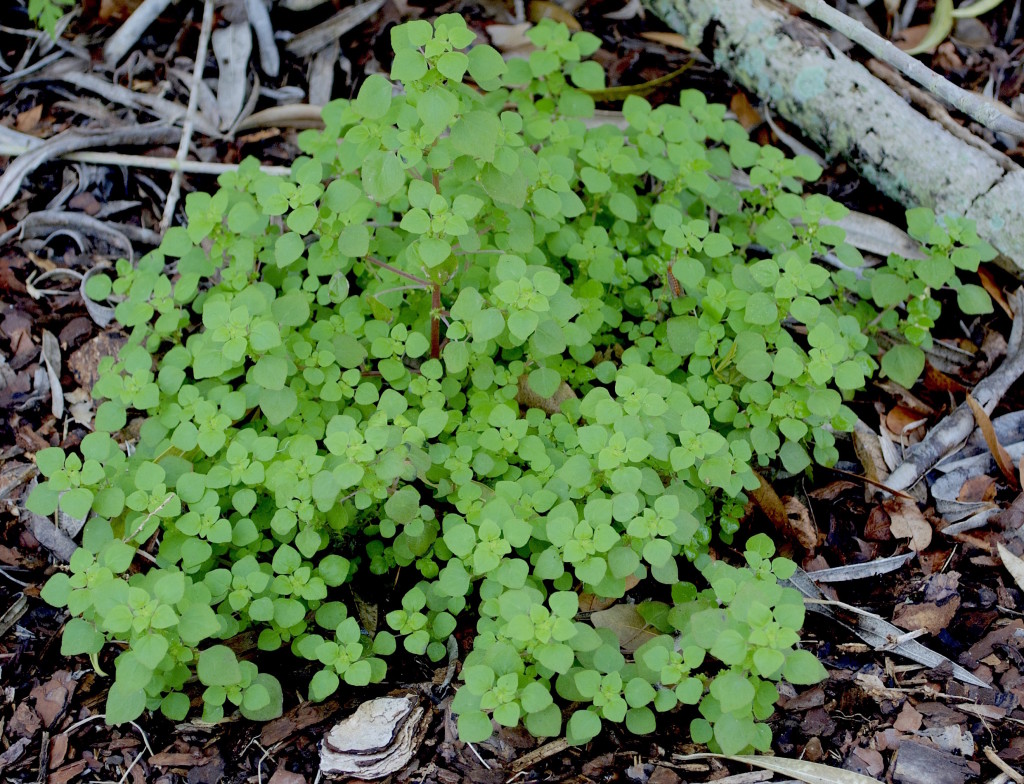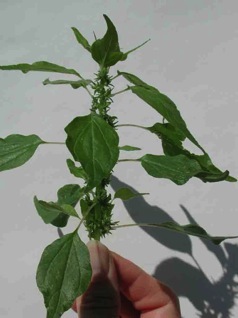Pellitory: Parietaria is a Whiz
Finding greens locally in the cooler months isn’t much of a challenge unless you’re looking for Pellitory . It likes to hide and move.
Pellitory, or Parietaria, is in the greater nettle family and likes it cool and dry, if not shady. It even grow on rocks up to 12,000 feet. Uncooked, pellitory has a hint of cucumber aroma, hence sometimes it’s called the Cucumber Weed. Cooked, it is bland, which suits some palates just fine because you can flavor it as you like. I have friends who just stuff it raw into tacos with other fixings.
Parietaria (pair-ee-eh-TAR-ee-uh) also known as Pellitory Over-the-Wall. It has a reputed split personality you should be aware of. Its purported double life may also explain why so many foraging books skip it. Many years ago I was told by foraging expert Richard “Dick” Deuerling (co-author of Florida’s Incredible Wild Edibles) that half the people who ate pellitory got the itches — like a niacin flush but longer lasting. I don’t get an all-over itchy feeling when I eat Parieitaria so I don’t think about it, but, if a person has allergies they should approach Parietaria with caution. Frankly in the decades since hence I have met only one person who get the itches from eating it. However, Dick, below left, was a stickler for details and I could have easily just met a lot of folks who don’t react to it.
While there is a difference between eating a plant and breathing its pollen, in the Mediterranean area pellitory, in particular Parietaria judaica, is becoming a significant problem. More than 82% of people who are allergic to pollen show an allergy to that particular Parietaria. Some Australian hospitals call the P. judaica the Asthma Weed and warn against it, labeling it dangerous. If you have allergies, or hay fever, Pellitory might be a plant to skip, or at least approach carefully.
That said, besides being an edible salad ingredient and pot herb for thousands of years, Parietaria has been used herbally, with a slight contradiction in constituents. Its attested main feature is that it is a diuretic of significant strength and good for kidney stones, bladder issues, et cetera. Yet, it is high in sodium which tends to make some folks retain water. On the other hand, Parietaria is high in potassium and nitrates, the latter of which a 2006 study showed helped lower blood pressure, which is often done by lowering ones fluids. Ben Johnson wrote centuries ago:
‘A good old woman . . . did cure me with sodden ale and pellitorie o’ the wall.’
The nutritional profile of a relative, P. diffusa, is per 100 grams fresh weight 155 calories, 5.4 grams of protein, 2.8 grams of carbohydrates, 0.6 grams fat and 5.2 grams fiber. As for minerals it has 883 mg of calcium, 585 mg sodium, 463 mg potassium, 200 mg magnesium, 80 mg phosphorus, 2.8 mg of iron, 1.2 mg zinc, 0.9 mg manganese, and 0.4 mg of copper.
There is also some debate if the plant as a treatment herb is more potent green or dried. There are arguments for both. Now, if you are still willing to try pellitory, know the complete plant also cleans glass and copper pots well. It’s botanical name, Parietaria, comes from the Latin word paries, meaning a wall. Of course, if you have been reading a lot of these articles you know by now that Latin is just a combination of stolen Etruscan and mangled Greek. “Paries” in Latin came from the Greek word “parifi” meaning edge. Parietaria likes to grow in the cracks of walls but it can also form large clumps, such as in my garden or under dry road bridges frequented by transients. The local species is Parietaria floridana.
Below is a recipe from the Italian book Piante Selvatiche by Roberto Gamacchio, which specializes in wild greenery.
Pasta with Parietaria
Ingredients:
Macaroni or spaghetti, 7 ounces dry
Parietaria 3.5 ounces
Béchamel sauce 2 ounces
salt
chilli
Cook the pasta “al dente”. Steam the Parietaria, salt and blend. Add the sauce and chilli to taste. Fold the sauce in the pasta, serve immediately, salt to taste
Green Deane’s “Itemized” Plant Profile
IDENTIFICATION: Six inches to a 14 inches tall in Florida, usually unbranched. Central stem is green, four-angled, it can be slightly hairy. The lanceolate leaves alternate. Each flower is surrounded by several green bracts that are longer than the flower. The flowers are green with no petals, four stamen. Grows in colonies. NO TEETH ON LEAVES. If you have a pellitory with teeth on the leaves you have misidentified an Acalypha, not edible.
TIME OF YEAR: Early winter in Florida, lasting just a few of months at best, December to around March, occasionally later in cool winters and very deep shade. Elsewhere usually during cool spring months.
ENVIRONMENT: Walls, fences, edges, cool dry areas, light shade, moist to slightly dry conditions.
METHOD OF PREPARATION: Edible raw or cooked. Try a small piece first, it may make some people who eat it raw itch for a while. Raw it is better chopped up in salads. HINT: Even when cooked the stems can be fibrous, so chopping or cutting them into bite-size length before cooking is recommended. The water pellitory is cooked in is considered by chefs to be excellent stock for making risotto.






This is one of the most noxious weeds in my garden in Istanbul! You can’t pull it because the stems are brittle and roots tenacious; you have to dig every one out. And every plant produces lots and lots of seeds… I had know idea it was edible! But I’ll proceed with caution because I do get the sneezes from it.
Being a Greek this is a tad difficult but I would advise being careful because your particular pellitory is a major allergen.
We have what I think is the P. judaica species rampant in our backyard here in Austin (pinkish stems and little pink dots where the leaves emerge from the stems). It has a delightful cucumber taste.
I pick bags and bags of this, along with chickweed. My chickens absolutely love and devour it. It’s a nice in between snack for them, easy to find and free! I haven’t had the nerve yet to take more than a nibble here or there.
I started eating it recently here in Florida. It is interesting how leaves are a bit hairy so when I wash them they kind of stick to each other. I was confused by flowers on the stem at first but now I got used to it. Lower part of the stem can sometimes be too firm to chew so I just toss that part and eat the rest. I wonder what happens to Pellitory when you cook it ? I ate it only in salad with some lemon sprinkled.
Whenever my dog has an upset stomach, she finds some growing around bushes and eats it. Within an hour she feels better. Unfortunately, it isn’t around for too long. The one she eats is the picture at the top of the page. Is the other picture below also pellitory?
Yes.
I have been researching this weed for years as I have recently moved to Florida where it grows a lot around my property in shaded areas and my dog does the exact same thing. Whenever he gets nauseous he goes straight for that plant and eats as much as he can find. I wonder if it really does have anti nauseous properties for humans? Or just canines?
My dog ( female long hair blue merle chi) is OBSESSED! Like cat nip for kitties! She is very selective tho with which leaves to eat…smells them and eats certain ones. Fascinating! I was so worried about this habit, now I won’t correct her free salad grazing snack!
Do Acalypha have square stems and if not, are all plants with square stems edible?
No, many square stemmed plants are not edible. There are no short cuts.
Pellitory is also a host plant for the Red Winged Admiral butterfly. I like to use it to make a cream cheese and red pepper sandwich.
Wonderful to know that it is a butterfly host – thanks!!
deane
i have pelatory growing in my yard during the summer and most times of the year , when you say only there for a short time – i do not know what that means – i see it all year long growing out of bottom of a pot in the shade?
Where do you live, Tony?
I live in florida – Orlando, casselberry
That is highly unusual as pellitory is very seasonal, usually restricted to three cooler months or so. However last year I did see some in July, first time in my life.
Mine grows year round aswell thou it is my black garden soil maybe this helps. I use it as ground cover under and around my other edibles since it helps keep the ground moist and the unwanted plants out.
I, too, have the form with the sturdier leaves and the flowers on the stems growing year-round, here in Ft. Lauderdale. The softer-leaved, more delicate, and lower-growing form disappears in the summer and didn’t use to reappear until spring. Now the soft form is here (in Feb-March), but the other form is also here. I thought the more erect form was simply the mature plant. Do you think they’re two different strains?
The picture at the top of the article looks exactly like something that grows like crazy here in Houston. I have not yet found out what it is called here. It doesn’t quite match the growing pattern you describe for the Florida plant, as it can be found all year – though seems to be somewhat more abundant in the winter months. I haven’t tried eating it, so don’t know if it tastes cucumber-y. How big are the leaves in the top picture? The second picture (with the hand for scale) has leaves much larger than what grows here. I’d love to find out if this stuff is actually edible. It is a major weed here, and a royal pain to clear out of my garden. If I can call it a crop….
Pellitory is very seasonal. Have you tried Foraging Texas?
pellitory or wall-pellitory? I didn’t realize they were even related. Your top pic is the soft, regular “pellitory,” Parietaria floridana (easy to pull); second pic, and description, is Parietaria officinalis (lichwort). Not to nitpick, but i’ve been trying to ID the second one (nettle-ish), which is strong and can grow quite tall (3′) tangled in ornamentals, has a long orange taproot, almost like a carrot. I didn’t even realize they were both “pellitory”! Very different plants.
What do you know about the long orange “carrot-ish” taproot?
I took what you call Parietaria officinalis to the extension service and they
identified it as floridiana. But definitely the year-round form in my garden had that strong tap-root where as the other one is very easy to take out.
I’m a bit confused– the top picture looks just like chickweed. Are you sure that’s pellitory? I’m used to seeing it with oblong/lance shaped leaves, even when it’s young and small. Are the two related?
No, they are not related but from a distance they can seem to be similar.
I live just south of Paris, and we have lots of Parietaria officinalis, which means, more or less, “the official one in the pharmacy”. It was apparently used for pretty much everything – good for what ails you it seems. I spent years ripping it out of my vegetable patch before I discovered it was better than most of my vegetables… When not eating it raw I use it the way I use nettles – either just steamed or tossed in a stir fry, or, if I am being fancy, I make a stuffed bread inspired from Georgian Khachapuri, with a generous layer of “pariétaire” as it is called in French, together with cheese (a mix of mozzarella and feta). You can find my recipe at my friend’s web site “Soil and Spice” in her “On Foraging” article. And at my local market there is a merchant selling cod and pariétaire puff pastry pockets.
I would like to be able to post a photo of a weed to see if anyone knows what and if it is edible. How do I do that?
You can post it in the Green Deane Forum on the UFO page (Unidentified Flowering Object) or email it to me: GreenDeane@gmail.com
In Florida, I have seen and eaten parietaria like the one in the photo at the top of your article. Where I live in NYC I have just found another form of what I believe to be parietaria with longer, thinner leaves. Same cucumber smell. Same color. Same green flowers on stem. It does not look like your second photo though– the leaves are lighter green and thinner than that. Are ALL forms of parietaria edible? I would like to try this one with the longer leaves, but not sure if all varieties are edible.
Hi Dean, I really enjoy your website for a few years now. Lately though it is very hard to read. Did you change the font of your newsletter? I have to copy it in the word document and change the font to be able to read it.
Love all the info though!!!!!!!!!!!
Thanks for writing. The site was rebuilt and came out with a smaller font. We’re trying to fix that.
I just cooked a pan of sweet brown rice with turmeric and ginger from my garden and a five gallon bucket of Parietaria floridana. My client wanted it out of their shade garden so I pulled it and brought it home. I’ve never had enough to cook like this. Mixed it with eggs and garlic, poured it over the hot rice and let it steam. YES! Delicious, subtle cucumber flavor, delicate green. Thank you once again for sharing your mad skills Dean
My dog, a toy poodle, is 11 and has been eating parietaria since she was a puppy. I live in Winter Park, Fl and as mentioned in the above comments, it usually disappears by the end of April. This year I decided to try and cultivate it in a small pot in the shade. It is now the end of May and my dog is grateful for the plant that has yet to decline.
Took me awhile to find the name of this plant because my chickens love it and eat it too the ground. I would recommend if you have a problem with this weed get yourself some chickens and they will eliminate it for you. My neighbors are highly allergic to this plant and I don’t think I am I will try eating it soon.
When you say allergic, how?
Does the Acalypha taste like cucumber? I have something in between the descriptions that my dogs were eating and I tasted. I wish I could include a picture.
I am finding this article and the comments very interesting, including the comments on chickens and dogs eating Pellitory. Unfortunately, after working removing it from a client’s garden on a few occasions I developed an intense allergy to it, so won’t be trying to eat it. The allergy in my case began with a skin rash reaction to contact with the leaves and progressed to massive hay-fever reaction and then bad asthma in reaction to the pollen. It is everywhere in San Francisco, pretty much all year. If only I could unleash an army of chickens in my neighborhood!
I’ve had 3 dogs who all like to eat Pellitory -Parietaria officinalis
Just encountered this article after spending a good while trying to ID a weed that grows in the production house at the greenhouse where I work (located in Pennsylvania). Parietaria floridana grows year-round under the benches where it is moist and cool and spreads quickly, and I had a lot of trouble iding it because I guess it’s not a common horticulture weed and none of the resources I have on greenhouse weeds mentioned it. Very interesting to find out that it’s edible! ( though not edible when grown on the floor of a greenhouse unfortunately)
do you have any idea where I can find seeds for this?
Is Parietaria floridana/Florida pellitory edible?
Yes.https://www.eattheweeds.com/pellitory-parietaria-is-a-whiz-2/